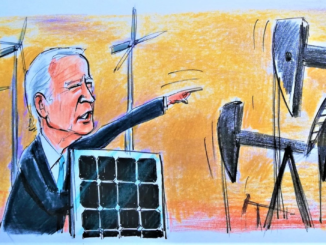
In a world where oil prices are currently languishing below $70 per barrel, with analysts predicting they could average in the mid-$60s for the remainder of 2025, it’s easy to assume a bearish outlook dominates the energy markets.
Yet, beneath this apparent oversupply narrative lies a confluence of factors poised to drive a significant upside shift in oil and gas prices. From tightening OPEC spare capacity to the persistent failure of renewables to displace fossil fuels, and amid looming fiscal pressures redirecting investments away from wind and solar, the stage is set for higher energy costs. This article explores these dynamics, drawing on recent developments and expert analyses to explain why the tide may soon turn.OPEC’s Spare Capacity: A Fragile Buffer Overestimated by MarketsOPEC’s spare crude oil production capacity has long served as a stabilizing force in global markets, valued at an estimated $200 billion annually for its role in mitigating supply disruptions.
Is Oil & Gas Right for Your Portfolio?
As of mid-2025, OPEC’s total spare capacity stands at around 4.11 million barrels per day (bpd), primarily concentrated in a handful of Middle Eastern Gulf countries like Saudi Arabia and the UAE.
This figure represents a historical high, but experts warn that the market may be significantly overestimating its effective usability, potentially leading to a $15 per barrel upside in oil prices.
Recent OPEC+ decisions to unwind voluntary production cuts—planning increases of about 400,000 bpd monthly from May to October 2025—have contributed to perceptions of oversupply, pushing the global oil market toward a surplus.
However, this strategy is a double-edged sword. Saudi Arabia’s share of global production has dipped to 11% in 2024 from a 13% average over the past three decades, signaling a deliberate play to reclaim market share while punishing quota cheaters.
If geopolitical tensions in the Middle East escalate without direct disruptions or if demand surprises to the upside, this spare capacity could prove less robust than assumed. As Ole Hansen of Saxo Bank noted, OPEC+ is ramping up to challenge higher-cost producers, but lower price expectations might force production dial-backs elsewhere.
Moreover, risks to this spare capacity—largely held by Saudi Arabia and the UAE—continue to loom, potentially tightening supply and supporting higher prices.
The International Energy Agency (IEA) forecasts global oil supply at 105 million bpd in May 2025, up 1.8 million bpd year-over-year, but with demand growth pegged at just 720,000 bpd for the year, any miscalculation in spare capacity could flip the market into deficit territory.
The Failure of Renewables to Displace Oil and Gas DemandDespite trillions invested in renewables, oil and gas continue to boom, rendering the net-zero energy transition increasingly unattainable under current trajectories. Global oil demand has surged from 92.5 million bpd in 2014 to over 103 million bpd in 2024, an 11% increase, while natural gas demand has risen 20% to over 4,200 billion cubic meters. Renewables like wind and solar have added 3,725 terawatt-hours (TWh) to global grids over the same period, yet they account for only about 15% of total generation, failing to replace fossil fuels at scale.
This persistence stems from inherent challenges: intermittency requires fossil fuel backups, often gas, and the high cost per unit of added electricity—over $1 billion per TWh—excludes grid upgrades and subsidies.
Recent developments underscore this shortfall. Saudi Aramco’s CEO has called the energy transition “oversold and under-delivered,” particularly in Asia, where fossil fuels dominate. Producers like the UAE (targeting 5 million bpd by 2027) and Guyana (over 660,000 bpd now, eyeing 1.3 million by 2030) are expanding output, contradicting net-zero goals.
Analysts argue that renewables are adding to the energy supply rather than substituting, with demand forecasts showing oil reaching 108 million bpd by the early 2030s and gas up 34% by 2050.
As one executive put it, the transition is “visibly failing on most fronts,” highlighting why oil and gas remain indispensable for transportation, industry, and chemicals.
Looming Fiscal Pressures and the Shift Away from Renewables Investments
Global fiscal risks are mounting in 2025, exacerbated by geopolitical tensions, trade disruptions, and policy shifts that could precipitate economic instability.
Regions pursuing aggressive net-zero policies, like the EU, Canada, and the UK, face potential fiscal challenges from deindustrialization as industries relocate to lower-cost fossil fuel-reliant areas.
Meanwhile, investments are pivoting away from wind and solar amid regulatory uncertainty and diminishing returns.BlackRock, the world’s largest asset manager, exemplifies this trend. In its 2025 annual letter, CEO Larry Fink omitted mentions of climate change, DEI, and ESG, instead advocating for more energy production, including nuclear.
The firm quit the Net Zero Asset Managers Initiative in January 2025, citing confusion and legal risks, and shifted from ESG to “transition investing.”
This move prompted outflows, with the Sierra Club Foundation redirecting $10.5 million away from BlackRock due to perceived insufficient commitment to environmental goals.
Case Studies: Sanctions, Supply Disruptions, and Booming Demand
The Bottom Line
Preparing for the Oversupply and demand uncertainties keeps prices subdued for now, the combination of overestimated OPEC spare capacity, renewables’ inability to supplant oil and gas, and fiscal strains redirecting capital toward fossils points to a bullish shift. Investors and policymakers should brace for higher prices as these realities unfold, potentially reshaping the global energy landscape in favor of oil and gas.
The world needs trillions of dollars invested in just replacing normal decline curves, so as Stu Turley has said, “If India can keep its demand for oil higher than China’s falling demand difference, we will see oil in the 80 dollar range.” While that is an oversimplification of the oil market, it highlights a critical point on the demand side of the equation.






